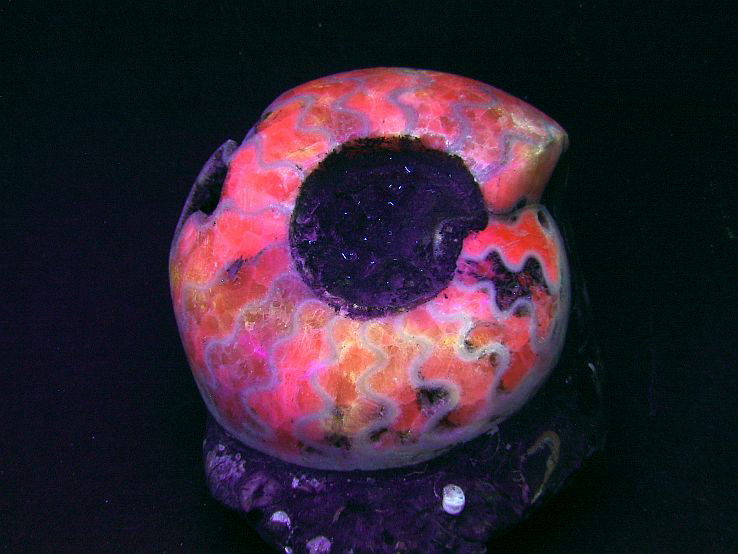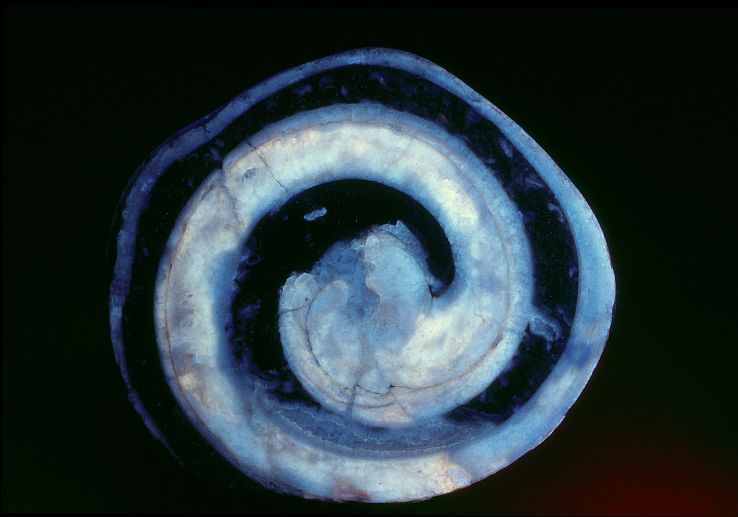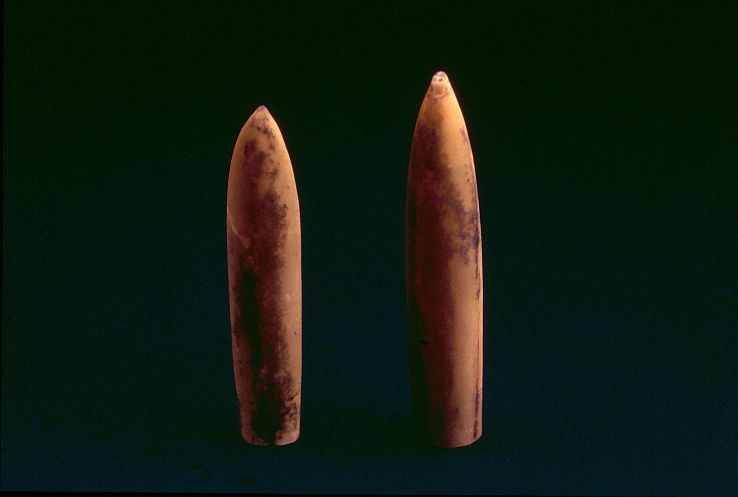Long wave UV
Trochacteon Acteonella: Russbach, Salzburg, Austria.
Cross section. Trochacteon Acteonella is a snail from the Early Cretaceous. The
species is now extinct. During fossilization, the animal has decomposed in its own
shell and has been replaced by calcite. The organic residues have been enclosed in
the mineral content. They are the source of a bright white fluorescence and a greenish
phosphorescence
Toucasia carinata: Lagnes, Luberon, Provence, France.
129.4-125 Ma, Barrémien (Lower-Cretaceous).
The inside of the shell is padded with nicely crystallized calcite. This fluoresces white under
all UV wavelengths. The material of the shell itself is completely replaced by silica. This
fluoresces relatively strong yellow, as many quartz forms of fossil origin do.
Agatized coral:
Withlacoochee river bed, Florida, USA.
Hollow coral "pipes" are converted to quartz,
var. agate. The pictures show the two halves
of a sawn-in-halve coral branch.
Click on the picture for zooming and
fluorescence.
The pictures show the specimen under resp.
normal light, fluorescence under long wave
UV, fluorescence under short and medium
wave UV.
The white fluorescence is caused by organic
matter, the green one by a little uranyl, which
always loves quartz varieties to nest in.
Belemnites: South Limburg, Belgium.
Belemnites are part of the inner skeleton of extinct 10-armed squid species. More
specifically the "rostrum". This silicified fossil fluoresces orange in long wave UV, like
much fossil quartz does.
Fossilized seabed (aragonite): Millau, Aveyron, Midi-Pyrénées, France
This polished slab is a cross-section of a piece of seabed from millions of years ago. The
remnants of small sea creatures sink to the bottom and are deposited into a pattern that
strongly reminds of the annual rings of trees. The calcium carbonate in these residues is
converted to aragonite. Such pieces contain a lot of information about climate and seasons,
but possibly also volcanic dust from during this deposition.

Ammonite: Mindanao, Philippines
Ammonites are an extinct subclass of squids (Cephalopoda). They were marine
animals that were present in large numbers worldwide in the late Paleozoic and
throughout the Mesozoic. They are found as fossils.
The specimen shown is perhaps the worst possible example of how to prepare such a
fossil. The whole shell has been removed so that only the mineral content and the
partitions of the shell remain. The red and orange fluorescence probably come from
manganese that behaves as an activator in calcite. It is quite logical to find manganese
because the ocean floor around the Philippines is dotted with manganese nodules.
Long wave UV
Long wave UV
Long wave UV
Short wave UV
Photo & Collection: Doug Bank Click on the photos to zoom
Agatized Coral: Tampa Bay area, Florida, U.S.A.
A real fossil coral of 38-25 million years old. The orange fluorescence is not easy to
explain. Sometimes porphyrine is found in such corals and shells, as biological pigment
and remnants of the metabolism of the disappeared organisms. It absorbs UV and blue
light around 410 nm and then fluoresces orange. It is a possibility but by no means
certain. The green and light blue emissions may come from a little uranyl that came
with the silica gel that filled the hollow coral stalks. Another explanation could be that a
little green fluorescent protein (GFP) has survived the test of time. This protein
absorbs UV and ensures that the coral does not burn through too much UV radiation.
Click on the photos too zoom
Photos and collection: Doug Bank,
Photo Ocean Center Maui: Axel Emmermann
Red Coral: Aleutian Islands, Alaska, United States of America
Technically speaking, this is not a fossil. The corals are still growing around the
Aleutian Islands, an archipelago that belongs to Alaska. The green emission is caused
by green fluorescent protein (GFP). This protein absorbs UV and is as such a natural
protection against an overdose of ultraviolet radiation that would be lethal for the coral.
Living corals mostly fluoresce strong green when exposed to UV or blue light. Coral
animals does not make these proteins themselves. This is done by algae
(Zooxanthellae) that live in the tissue of the coral animals. This symbiosis allows the
coral to receive a lot of light to grow without burning. The last of the four photos shows a
living coral display under UV-light at the Maui Ocean Center, Wailuku, Maui, Hawaii,
United States of America.
Trochacteon Acteonella
Toucasia carinata
Agatized coral
Belemnites
Fossilized seabed (aragonite)
Ammonite
Agatized Coral
Red Coral



